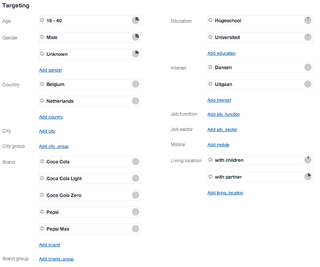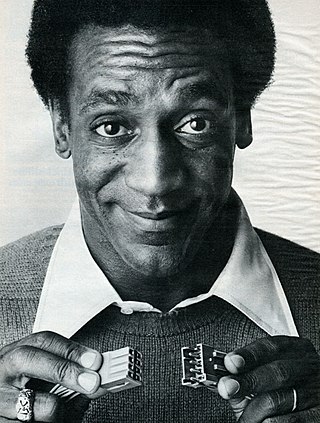Related Research Articles

Advertising is the practice and techniques employed to bring attention to a product or service. Advertising aims to present a product or service in terms of utility, advantages and qualities of interest to consumers. It is typically used to promote a specific good or service, but there are a wide range of uses, the most common being commercial advertisement.

A television advertisement is a span of television programming produced and paid for by an organization. It conveys a message promoting, and aiming to market, a product, service or idea. Advertisers and marketers may refer to television commercials as TVCs.

Got Milk? is an American advertising campaign on television and YouTube encouraging the consumption of milk and dairy products. Created by the advertising agency Goodby Silverstein & Partners for the California Milk Processor Board in 1993, it was later licensed for use by milk processors and dairy farmers. It was launched in 1993 by the "Aaron Burr" television commercial, directed by Michael Bay. The national campaign, run by MilkPEP began to add the "got milk?" logo to its "Milk Mustache" ads in 1995.

Direct marketing is a form of communicating an offer, where organizations communicate directly to a pre-selected customer and supply a method for a direct response. Among practitioners, it is also known as direct response marketing. In contrast to direct marketing, advertising is more of a mass-message nature.
Email marketing is the act of sending a commercial message, typically to a group of people, using email. In its broadest sense, every email sent to a potential or current customer could be considered email marketing. It involves using email to send advertisements, request business, or solicit sales or donations. Email marketing strategies commonly seek to achieve one or more of three primary objectives: build loyalty, trust, or brand awareness. The term usually refers to sending email messages with the purpose of enhancing a merchant's relationship with current or previous customers, encouraging customer loyalty and repeat business, acquiring new customers or convincing current customers to purchase something immediately, and sharing third-party ads.
Activia is a brand of yogurt owned by Groupe Danone and introduced in France in 1987. As of 2013, Activia is present in more than 70 countries and on 5 continents. Activia is classified as a functional food, designed to improve digestive health.

Advertising media selection is the process of choosing the most efficient media for an advertising campaign. To evaluate media efficiency, planners consider a range of factors including: the required coverage and number of exposures in a target audience; the relative cost of the media advertising and the media environment. Media planning may also involve buying media space. Media planners require an intricate understanding of the strengths and weaknesses of each of the main media options. The media industry is dynamic - new advertising media options are constantly emerging. Digital and social media are changing the way that consumers use media and are also influencing how consumers acquire product information.
Apple Inc. has had many notable advertisements since the 1980s. The "1984" Super Bowl commercial introduced the original Macintosh mimicking imagery from George Orwell's 1984. The 1990s Think Different campaign linked Apple to famous social figures such as John Lennon and Mahatma Gandhi, while also introducing "Think Different" as a new slogan for the company. Other popular advertising campaigns include the 2000s "iPod People", the 2002 Switch campaign, and most recently the Get a Mac campaign which ran from 2006 to 2009.
Marketing effectiveness is the measure of how effective a given marketer's go to market strategy is toward meeting the goal of maximizing their spending to achieve positive results in both the short- and long-term. It is also related to marketing ROI and return on marketing investment (ROMI). In today's competitive business environment, effective marketing strategies play a pivotal role in promoting products or services to target audiences. The advent of digital platforms has further intensified competition among businesses, making it imperative for companies to employ innovative and impactful marketing techniques. This essay examines how various types of advertising methods can be utilized effectively to reach out to potential consumers
Ad tracking, also known as post-testing or ad effectiveness tracking, is in-market research that monitors a brand’s performance including brand and advertising awareness, product trial and usage, and attitudes about the brand versus their competition.
Mobile advertising is a form of advertising via mobile (wireless) phones or other mobile devices. It is a subset of mobile marketing, mobile advertising can take place as text ads via SMS, or banner advertisements that appear embedded in a mobile web site.

Digital marketing is the component of marketing that uses the Internet and online-based digital technologies such as desktop computers, mobile phones, and other digital media and platforms to promote products and services. It has significantly transformed the way brands and businesses utilize technology for marketing since the 1990s and 2000s. As digital platforms became increasingly incorporated into marketing plans and everyday life, and as people increasingly used digital devices instead of visiting physical shops, digital marketing campaigns have become prevalent, employing combinations of search engine optimization (SEO), search engine marketing (SEM), content marketing, influencer marketing, content automation, campaign marketing, data-driven marketing, e-commerce marketing, social media marketing, social media optimization, e-mail direct marketing, display advertising, e-books, and optical disks and games have become commonplace. Digital marketing extends to non-Internet channels that provide digital media, such as television, mobile phones, callbacks, and on-hold mobile ringtones. The extension to non-Internet channels differentiates digital marketing from online marketing.
Location-based advertising (LBA) is a form of advertising that integrates mobile advertising with location-based services. The technology is used to pinpoint consumers location and provide location-specific advertisements on their mobile devices.

Targeted advertising is a form of advertising, including online advertising, that is directed towards an audience with certain traits, based on the product or person the advertiser is promoting.
Social network advertising, also known as social media targeting, is a group of terms used to describe forms of online advertising and digital marketing that focus on social networking services. A significant aspect of this type of advertising is that advertisers can take advantage of users' demographic information, psychographics, and other data points to target their ads.
Advertising to children refers to the act of advertising products or services to children as defined by national laws and advertising standards.

Social media marketing is the use of social media platforms and websites to promote a product or service. Although the terms e-marketing and digital marketing are still dominant in academia, social media marketing is becoming more popular for both practitioners and researchers.
"Secret Tournament" was a Nike global advertising campaign coinciding with the 2002 FIFA World Cup. With a marketing budget estimated at US$100 million, the advert featured 24 top contemporary football players and former player Eric Cantona as the tournament "referee". It was directed by film director and Monty Python member Terry Gilliam.

American comedian and actor Bill Cosby was a popular spokesperson for advertising from the 1960s – before his first starring television role – until the early 2000s. He started with White Owl cigars, and later endorsed the Jell-O frosty ice pop treats Pudding Pop, gelatin, Del Monte, Ford Motor Company, Coca-Cola, American Red Cross, Texas Instruments, Service Merchandise, E. F. Hutton & Co., Kodak, and the 1990 United States Census. As of 2002, Cosby held the record for being the longest-serving celebrity spokesperson for a product, through his work with Jell-O. In 2011, he won the President's Award for Contributions to Advertising from the Advertising Hall of Fame.
The United States food and beverage industry has increased the amount of advertising that intensively and aggressively targets children through multiple channels. Food marketers know that the youth consumers have equal if not more spending power than adults, they hold purchasing influence, and have the potential to be lifelong consumers. The advertisements for products predominantly high in sugar and fat have increased and have had an effect on the major health epidemic in the US of Childhood obesity, and as such are inconsistent with national dietary recommendations. Food advertisements have moved from the television into the classroom. Marketing companies are exploring new creative techniques to reach their target audience, young children, through promotions, contests, and incentive programs. As a result, the US has progressively been placing regulations on how much advertising is allowed during children's programming.
References
- 1 2 3 Feature article: How consumer insight makes or breaks a new brand - Customer loyalty, customer retention, and customer relationship marketing daily news and information - free, unbiased news for the marketing executive or researcher Archived 2006-03-28 at the Wayback Machine
- 1 2 Juan Metzger, 79, is Dead; He Put the Fruit in Yogurt
- 1 2 Sloane, Leonard (16 August 1976). "Dannon Visits a Soviet Village". The New York Times. Archived from the original on 23 April 2018. Retrieved 21 January 2024.
- 1 2 Acidophilus Archived 2010-02-22 at the Wayback Machine
- ↑ Lubalin, Peter (3 January 1977). "To Russia, with yogurt" (PDF). Broadcasting Magazine. p. 11. Archived from the original (PDF) on 22 November 2023. Retrieved 21 January 2024.
- ↑ "In Soviet Georgia". YouTube . 31 December 2012. Retrieved 26 August 2020.
- ↑ 100 best TV commercials - includes related article on CEO involvement in corporate advertising | Chief Executive, The | Find Articles at BNET.com
- ↑ "Ad Age Advertising Century: Top 100 Advertising Campaigns". Archived from the original on 2005-12-18. Retrieved 2005-12-19.